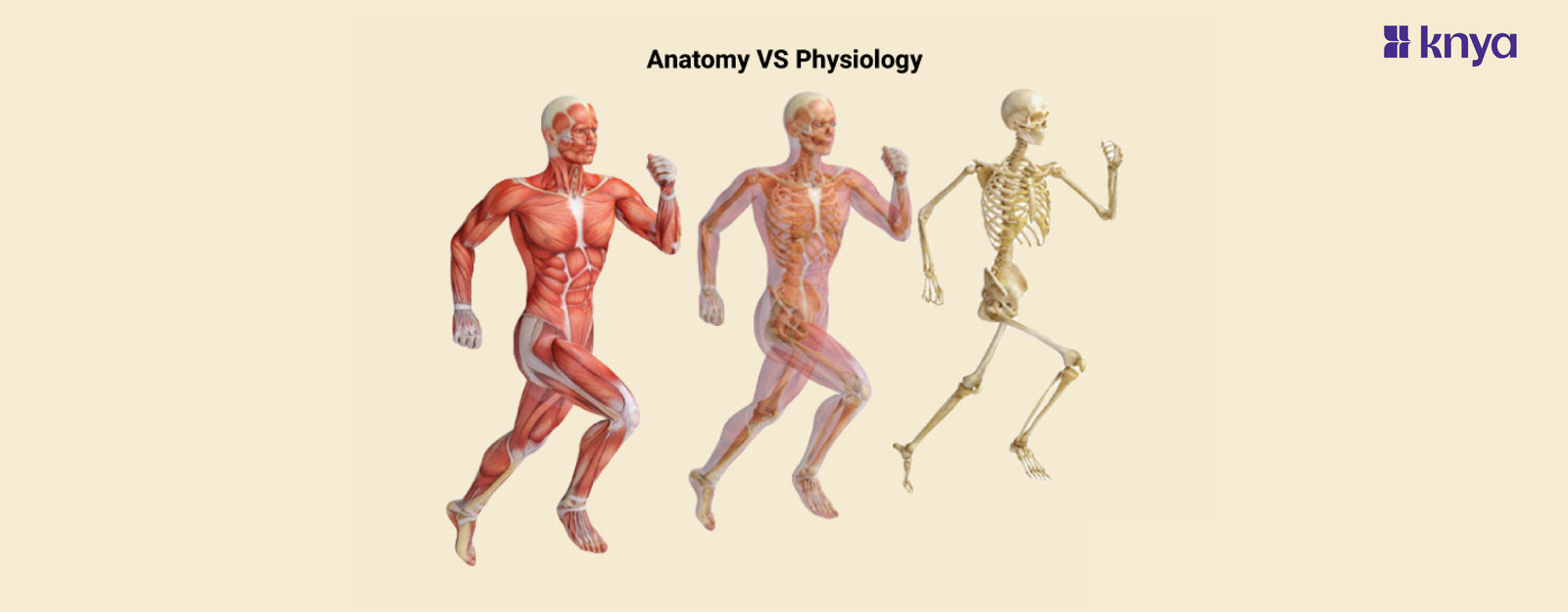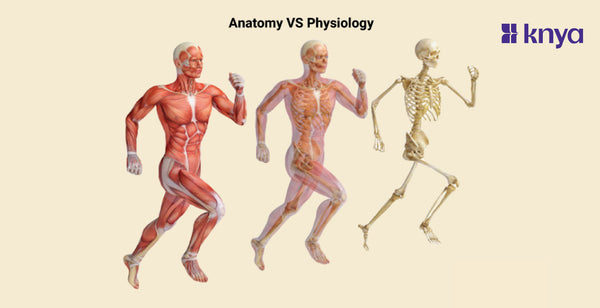Anatomy and Physiology are two closely related but distinct branches of biological science that collectively form the foundation of our understanding of the human body. While both disciplines delve into the intricacies of the body's structure and function, they focus on different aspects, providing complementary insights into the complex machinery of life. Let's explore the key disparities between Anatomy and Physiology:
Difference Between Anatomy and Physiology
Read Difference Between Anatomy and Physiology in Tabular Format
|
Aspect |
Anatomy |
Physiology |
|
Definition |
Study of the structure and organization of body parts. |
Study of the functions and processes of living organisms. |
|
Focus |
Deals with the form and structure of body parts. |
Concerned with the way body parts work and carry out their functions. |
|
Subdivisions |
Includes gross anatomy (visible to the naked eye) and microscopic anatomy. |
Includes cell physiology, organ physiology, and systemic physiology. |
|
Methods |
Involves dissection, imaging techniques, and observation. |
Involves experimentation, observation, and analysis of physiological processes. |
|
Examples |
Examining the heart's chambers and blood vessels. |
Studying how the heart pumps blood and regulates blood pressure. |
|
Time Factor |
Can be relatively static, as structures don't change rapidly. |
Involves dynamic processes that occur over time. |
|
Relationship |
Provides the foundation for understanding physiological functions. |
Physiology builds on anatomical knowledge to explain how structures work. |
|
Interconnectedness |
Structures are interconnected and influence each other. |
Functions are interconnected and rely on the integration of various systems. |
|
Medical Application |
Important for surgical procedures and diagnostics. |
Crucial for understanding disease mechanisms and developing treatments. |
Check out the best Medical Scrub Suits here
What is Anatomy
Anatomy is the intricate study of the structure and organization of living organisms, providing a comprehensive understanding of their form and function. This discipline delves into the composition and arrangement of tissues, organs, and systems within the body, unraveling the complexities that underlie the marvel of life. At its core, anatomy explores the architecture of biological entities, offering invaluable insights into the relationships between different components and the mechanisms that sustain life. Here are key bullet points encapsulating the essence of anatomy:
- Structural Exploration: Anatomy focuses on investigating the physical structure of organisms, encompassing everything from the microscopic building blocks, such as cells and tissues, to the macroscopic arrangements of organs and systems.
- Functional Correlation: It goes beyond mere structural analysis by elucidating how different anatomical elements work together to facilitate various physiological processes, ensuring the seamless functioning of living organisms.
- Subdivisions: Anatomy comprises several specialized branches, including gross anatomy (macroscopic study), microscopic anatomy (histology), and developmental anatomy, each contributing to a holistic understanding of the intricacies inherent in living organisms.
- Clinical Relevance: Anatomical knowledge forms the foundation for medical and healthcare disciplines, guiding clinicians in diagnosis, treatment, and surgical interventions. It serves as a fundamental tool for medical practitioners, providing essential insights into the human body's normal and pathological states.
- Evolutionary Significance: The study of anatomy offers a glimpse into the evolutionary adaptations that have shaped the diversity of life. By examining anatomical structures across different species, scientists can trace the evolutionary trajectories that have led to present-day biodiversity.
What is Physiology
Physiology, the fascinating study of how living organisms function and maintain life, delves into the intricate mechanisms that govern the human body and other organisms. At its core, physiology explores the dynamic interplay of various physiological systems that work seamlessly to sustain life processes. This interdisciplinary science integrates principles from biology, chemistry, physics, and anatomy to unravel the complex web of functions within living organisms. Let's explore the key facets of physiology through the following bullet points:
- Systems Approach: Physiology adopts a systems-based approach, studying the functions of individual organs, tissues, and cells, as well as their interactions within larger systems.
- Homeostasis: One of its fundamental principles is the concept of homeostasis, wherein living organisms maintain stable internal conditions despite external fluctuations.
- Subfields: Physiology comprises various subfields, including neurophysiology (study of the nervous system), cardiovascular physiology (study of the heart and blood vessels), and endocrinology (study of hormones and glands), among others.
- Experimental Methods: Researchers in physiology employ a range of experimental methods, such as electrophysiology, imaging, and molecular techniques, to investigate the mechanisms underlying physiological processes.
- Clinical Relevance: Understanding physiological principles is crucial in the medical field, as it forms the basis for diagnosing and treating various diseases and conditions.
Check out best Lab Coats for Students here!
Similarities between Anatomy and Physiology
Anatomy and physiology are closely related fields of study in biology that deal with the structure and function of living organisms. While they are distinct disciplines, there are several key similarities between anatomy and physiology:
- Interdependence:
- Anatomy: Focuses on the structure and organization of living organisms, including organs, tissues, and cells.
- Physiology: Concentrates on the functions and mechanisms that allow living organisms to carry out various processes.
- Complementary Nature:
- Anatomy: Provides the foundation by identifying the parts and their relationships within an organism.
- Physiology: Builds upon the anatomical knowledge by explaining how these structures work together to maintain life processes.
- Integration:
- Anatomy: Involves the study of different body parts and their spatial relationships, both internally and externally.
- Physiology: Examines the integration of various systems and organs to understand how they collaborate to perform specific functions.
- Holistic Approach:
- Anatomy: Requires a holistic understanding of the entire organism, from the macroscopic level (organs, tissues) to the microscopic level (cells, molecules).
- Physiology: Involves a comprehensive analysis of how different systems work together to maintain homeostasis and support life.
- Applied Knowledge:
- Anatomy: Provides the structural basis for medical imaging, surgery, and other applied sciences.
- Physiology: Offers insights into the functioning of organs and systems, contributing to medical diagnostics, treatment, and overall healthcare.
- Interdisciplinary Nature:
- Anatomy: Overlaps with other disciplines such as embryology, histology, and comparative anatomy.
- Physiology: Integrates with biochemistry, pharmacology, and other fields to understand the biochemical and molecular mechanisms underlying physiological processes.
- Research and Education:
- Anatomy: Forms the basis for anatomical research and education, involving dissections, imaging, and morphological studies.
- Physiology: Provides the framework for understanding biological functions, with research often focusing on cellular and systemic processes.















